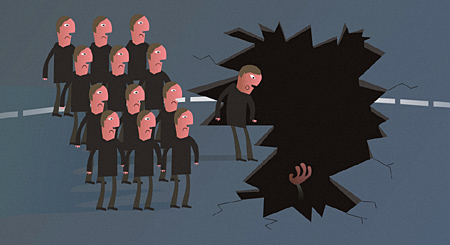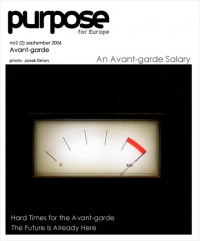
Feature
Future is here
Regrettably though – it’s over and done with. Nothing can reconstruct the climate of the beginning of the previous century, when art felt a sudden desire to rise above the horizon of what was regarded as holly and intransgressible. One can risk the claim that this unique gesture has come to an end, winded up, exhausted itself. It was too perfect to last. Too alive not to be able to die. Such is the nature of all acts of transgressive character – they cannot last forever. Now we can only go back emotionally to those days and summon ineffectively their spirit, which, in contemporary, petrified culture usually takes grotesque forms that manifest themselves in blatant reproductions of great avant-garde artists and in decorating apartments of modern middle class with their works. Today, almost at every turn, we come across more or less successful attempts to fulfil futurists’ dreams; advertisements and films (particularly their commercial variants) are trying to speak to us with trivialized version of surrealists’ language. This proves the significance of those days, but at the same time points up unprecedented emptiness of the present time.
A similar thing occurred in popular music. Everything that happened at the end of the 1970s and the beginning of the 1980s (when pop music felt a desire to become art, when punk spread its wings, an industrial scene emerged, electro artists were taking their first steps, etc.) showed similar ambitions. All that counted were uncompromisingness, experiment and innovativeness. Those were the last days of musical manifestos. Later, as usual in such cases, avant-garde impulses began to cease. Something burned out. Today we can only copy those gestures and repeat them endlessly – such a post-modernistic game...

illustration: Tomasz Kaczkowski
But maybe avant-garde is still possible? Maybe some signs can be spotted on the earth or in the sky to show the possibility of the revival of this courageous spiritual attitude? If yes, they should be sought not in the art itself, but at the interface between a few areas of man’s intellectual activity: art, science and philosophy. It seems that the next spiritual dash will be the act not of man, but of a machine – or more precisely: of man linked to a machine, of a “post-man” (as contemporary researchers on culture say).
I have recently read an interesting book on predictions for the future. Thirty eminent philosophers, specialists in various areas of life, tried to predict how the world and man will change in the less or more distant future. In my opinion, the most interesting chapters are those which treat about the influence of machines on man. Since it became obvious that without machines we wouldn’t manage in the contemporary world, man has changed, as have his perception, his way of thinking, as has human identity. Avant-garde, “the vanguard” of human community, is an army of machines. Everything suggests that this tendency will last and develop.
A very interesting chapter was penned by Sherry Turkle, a researcher who deals with the problems of relations (mainly emotional) between machines and man. Turkle observes that it is not important whether in the future machines will be intelligent in the way people are (will have their own identity, their ego). What is much more important is the moment when man begins to treat a machine as if it were intelligent (begins to ascribe to it human characteristics, begins to believe it possesses a human identity, an ability to feel). Man falls in love with the machine, which leads to the development of a certain new existence, biological-technological hybrid. On the other hand, this “humanisation” of machines brings changes in the perception of man’s own identity. It is very well visible in the Internet. Lots of people love “to play” with their identity, to melt in the kaleidoscope of artificially created identities. The simulation of a self has become extremely tempting. This tendency will develop with the development of opportunities offered by electronic simulation. Will we live to see the moment when our own identity deteriorates? In fractal structures of the net there are no answers to those questions yet, but they are worth asking. And this is what modern art, science and philosophy do.
It seems that all the dreams of avant-garde artists fade when compared to what is offered by modern science with its whole technological base. The future has never been so close. We live in very interesting times, and that’s why we should devote ourselves to their profound exploration. Modern artists know that, and so they obsessively explore the space of modern media which have become something more than a mirror in which we can look at ourselves. Electronic media have changed our self-image. What is that we can see on computer screens? How strong does it influence our perception of the world? Where does man end and a machine start? Those most intriguing questions should last for a long time. But wait…”us” – means who?...Who is this “I” that is asking questions? Does the symbiotic relation between man an the machine allow such questions? Is there still any “I”, or is that another link which refers us to nowhere?
Check the archive

nr 25 October 2006
theme of the issue:
AVANT-GARDE
< spis treści
Article
From the Editors
Presentation
Janek Simon
Analysis
Avant-garde hard time - Artur Zaguła
Career in Culture
Souls agreement - interview with Agula i Tom Swoboda
Culture Industries
Avant-garde salary - Artur Zaguła
Workshop
To create and live - Maciej Mazerant
Young Culture
Something new - conversation with Jankiem Simonem
Feature
Future is here - Kuba Wandachowicz
On the margin
Avant-garde - conversation with custodian Paweł Jarocki





